Oscillator circuit
Perfect capacitor and coil. How the oscillations occur, where the electrons move when the magnetic field of the coil increases and disappears.
An oscillating circuit is a closed electrical circuit consisting of a coil and a capacitor. Let us denote the inductance of the coil by the letter L, and the electrical capacity of the capacitor by the letter C. An oscillator circuit is the simplest of electrical systems in which free harmonic electromagnetic oscillations can occur.
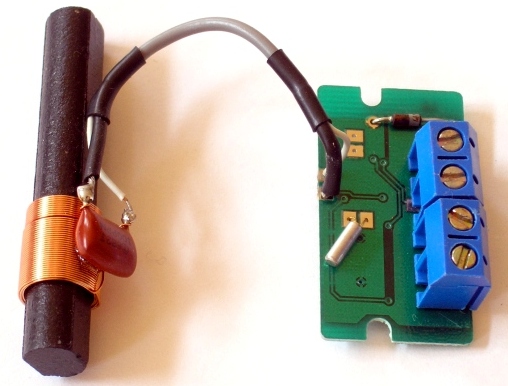
Of course, a real oscillating circuit always includes not only a capacitance C and an inductance L, but also connecting wires, which certainly have an active resistance R, but let's leave the resistance out of the scope of this article, you can learn about it in the section on the quality factor of the vibrating system. So, we consider an ideal oscillator circuit and start with a capacitor.
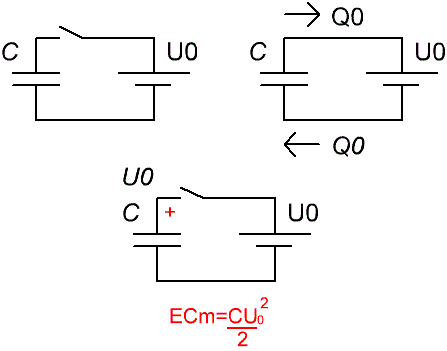
Let's say there is a perfect capacitor. Let us charge it from the battery to a voltage U0, that is, create a potential difference U0 between its plates so that it becomes "+" on the upper plate and "-" on the lower one, as is usually indicated.
What does it mean? This means that with the help of a source of external forces, we will move a certain part of the negative charge Q0 (consisting of electrons) from the upper plate of the capacitor to its lower plate. As a result, an excess of negative charge will appear on the bottom plate of the capacitor, and the top plate will lack exactly that amount of negative charge, meaning an excess of positive charge. After all, initially the capacitor was not charged, which means that the charge of the same sign on both of its plates was absolutely equal.
So, charged capacitor, the upper plate is positively charged (because electrons are missing) relative to the lower plate, and the lower plate is negatively charged relative to the upper one. In principle, for other objects, the capacitor is electrically neutral, but inside its dielectric there is an electric field through which the opposite charges on the opposite plates interact, namely, they tend to attract each other, but the dielectric, by its very nature, does not allow for this to happen. At this moment, the energy of the capacitor is maximum and is equal to ECm.
 Now let us take an ideal inductor. The path is made of a wire that has no electrical resistance at all, that is, it has the perfect ability to pass an electrical charge without interfering with it. Let's connect the coil in parallel with the newly charged capacitor.
Now let us take an ideal inductor. The path is made of a wire that has no electrical resistance at all, that is, it has the perfect ability to pass an electrical charge without interfering with it. Let's connect the coil in parallel with the newly charged capacitor.
What will happen? The charges on the plates of the capacitor, as before, interact, tend to attract each other, — the electrons from the lower plate tend to return to the upper, because from there they were dragged by force to the lower when the capacitor was charged.The system of charges tends to return to a state of electrical equilibrium, and then a coil is attached—a wire twisted into a spiral that has inductance (the ability to prevent current from being changed by a magnetic field when that current passes through it)!
Electrons from the lower plate rush through the wire of the coil to the upper plate of the capacitor (we can say that at the same time the positive charge rushes to the lower plate), but they cannot immediately slide there.
Why? Because the coil has inductance, and the electrons moving through it are already currents, and because current means there must be a magnetic field around it. So the more electrons enter the coil, the greater the current becomes, and the the larger the magnetic field around the coil appears.
When all the electrons from the bottom plate of the capacitor have entered the coil — the current in it will be at its maximum Im, the magnetic field around it will be the greatest that this amount of moving charge can create while in its conductor. At this point, the capacitor is completely discharged, the energy of the electric field in the dielectric between its plates is equal to zero EC0, but all this energy is now contained in the magnetic field of the coil ELm.
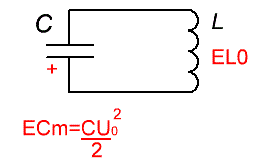
And then the magnetic field of the coil starts to decrease because there is nothing to support it, because no more electrons are flowing in and out of the coil, there is no current, and the disappearing magnetic field around the coil generates an eddy electric field in its wire that pushes the electrons further to the top plate capacitor where they were so eager.And at the moment when all the electrons were on the upper plate of the capacitor, the magnetic field of the coil became equal to zero EL0. And now the capacitor is charged in the opposite direction to that which was charged at the very beginning.
The upper plate of the capacitor is now negatively charged and the lower plate is positively charged. The coil is still connected, its wire still providing a free path for electrons to flow, but the potential difference between the plates of the capacitor is again realized, although opposite in sign to the original.
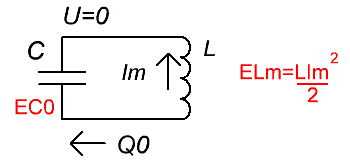 And the electrons again rush into the coil, the current becomes maximum, but since it is now directed in the opposite direction, the magnetic field is created in the opposite direction, and when all the electrons return to the coil (as they move down), the magnetic field is no longer accumulates, now it begins to decrease, and the electrons are pushed further - to the lower plate of the capacitor.
And the electrons again rush into the coil, the current becomes maximum, but since it is now directed in the opposite direction, the magnetic field is created in the opposite direction, and when all the electrons return to the coil (as they move down), the magnetic field is no longer accumulates, now it begins to decrease, and the electrons are pushed further - to the lower plate of the capacitor.
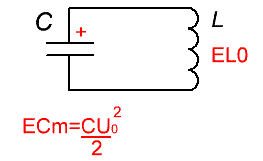
And at the moment when the magnetic field of the coil became equal to zero, it disappeared completely, — the upper plate of the capacitor is again positively charged relative to the lower one. The condition of the capacitor is similar to what it was at the beginning. A full cycle of one oscillation occurred. And so on and so on .. The period of these oscillations, depending on the inductance of the coil and on the capacitance of the capacitor, can be found by Thomson's formula:

